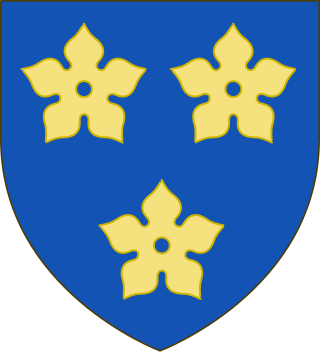
Hugh de Plessets [lower-alpha 1] (died 1301), Lord of Hooknorton was an English noble. He served in English campaign in Scotland.

Hugh de Plessets [lower-alpha 1] (died 1301), Lord of Hooknorton was an English noble. He served in English campaign in Scotland.
Hugh was the son of Hugh de Plessets and Isabel Bisset. He served in the wars in Scotland, [1] and was summoned to parliament by writ of summons on 6 February 1299. [2] [3] He was succeeded by his son Hugh. [4]

Baron Audley is a title in the Peerage of England first created in 1313, by writ to the Parliament of England, for Sir Nicholas Audley of Heighley Castle, a member of the Anglo-Norman Audley family of Staffordshire.

Baron Kingsale is a title of the premier baron in the Peerage of Ireland. The feudal barony dates to at least the thirteenth century. The first peerage creation was by writ.

Earl of Clanricarde is a title that has been created twice in the Peerage of Ireland, first in 1543 and again in 1800. The former creation became extinct in 1916 while the 1800 creation is extant and held by the Marquess of Sligo since 1916.

Ralph de Stafford, 1st Earl of Stafford, 2nd Baron Stafford, KG, of Stafford Castle and Madeley Castle in Staffordshire, was an English nobleman and a notable soldier during the Hundred Years' War against France.

The House of Burgh or Burke was an ancient Anglo-Norman and later Hiberno-Norman aristocratic dynasty which held the earldoms of Kent, Ulster, Clanricarde, and Mayo at various times, provided queens consort of Scotland and Thomond and kings of Britain, and played a prominent role in the Norman invasion of Ireland.

Thomas Howard, 8th Duke of Norfolk, Earl Marshal was an English peer and politician. He was the first son of Lord Thomas Howard and Mary Elizabeth Savile. Upon the death of his uncle Henry Howard, 7th Duke of Norfolk, he inherited the titles of 17th Baron Furnivall and 8th Duke of Norfolk. He married Maria Shireburn, daughter of Sir Nicholas Shireburn, 1st and last Bt., of Stonyhurst Hall, on 26 May 1709, when she was age 16 and a half, with a fortune of more than £30,000.

Lieutenant-General Charles Butler, 1st Earl of Arran, de jure3rd Duke of Ormonde (1671–1758) was an Anglo-Irish peer. His uncle Richard was the 1st Earl of Arran of the first creation. The titles were re-created for Charles in 1693. His elder brother, the 2nd Duke of Ormonde, was attainted during the Jacobite rising of 1715, but in 1721 Arran was allowed to buy the estate back. At the death of the 2nd Duke, he succeeded as de jure 3rd Duke of Ormonde in the Irish peerage but did not claim the title.

Baron Bourke of Castleconnell was a title in the Peerage of Ireland created on 16 May 1580 for Sir William Bourke. The eighth baron was attainted and the barony forfeited in 1691.
Baron La Poer, de la Poer, is a title in the Peerage of Ireland held by the Marquess of Waterford. Its creation is the sole instance in the law of the Kingdom of Ireland recognising a peerage by writ.

Thomas Burgh, 3rd Baron Burgh KG 3rd Baron Borough of Gainsborough, de jure7th Baron Strabolgi and 9th Baron Cobham of Sterborough was the son of William Burgh, 2nd Baron Burgh and Lady Katherine Clinton, daughter of Edward Clinton, 1st Earl of Lincoln and Elizabeth Blount, former mistress of King Henry VIII. He was one of the peers who conducted the trial of the Duke of Norfolk in 1572.
Geoffrey Talbot was an Anglo-Norman nobleman in medieval England. Holding lands around Swanscombe in Kent, he is often considered to have been the feudal baron of Swanscombe. Besides his lands, he was also given custody of Rochester Castle. His heir was his son, also named Geoffrey.

Hugh Dacre, 4th Baron Dacre (1335–1383) was an English nobleman. He was born in 1335, the youngest son of Ralph Dacre, 1st Baron Dacre and his wife Margaret de Multon, 2nd Baroness Multon of Gilsland. His two older brothers preceded him in the barony, but both died childless. His brother William, the second baron, married but died childless in 1361. His brother Ralph, the third baron, was a clergyman who died unmarried and without issue in 1375. Hugh may have been implicated in his predecessor's death; he and Nicholas Harrington were excommunicated by the Archbishop of York, likely in connection with the murder, and they were both presented for the murder at Preston, though they escaped long-term repercussions.

Hugh Poyntz, 1st Baron Poyntz, Lord of Curry Mallet was an English noble. He fought in the wars in Wales, Gascony and Scotland. He was a signatory of the Baron's Letter to Pope Boniface VIII in 1301.

Hugh Bardolf, 1st Baron Bardolf, Lord of Wormegay was an English noble. He served in the wars in France and Scotland and was a signatory of the Baron's Letter to Pope Boniface VIII in 1301.

Peter de Mauley, 1st Baron Mauley, Lord of Mulgrave was an English noble. He served in the wars in Wales, Gascony and Scotland and was a signatory of the Baron's Letter to Pope Boniface VIII in 1301.

Alan de Plugenet, 2nd Baron Plugenet, Lord of Preston Plucknett was an English noble. He served in English campaigns in Scotland.

Serlo de Lansladron, 1st Baron Lansladron, Lord of Lansladron was an English noble. He fought in the wars in Scotland.

William de Rithre, 1st Baron Rithre, Lord of Rithre was an English noble. He fought in the wars in Gascony and Scotland.

Henry de L'Orti, Lord of Curry Revell and Esseleigh was an English noble. He served in English campaigns in Wales and Scotland.

Nicholas Meinill, 1st Baron Meinill, Lord of Whorlton was an English noble. He fought in the wars in Wales and Scotland.